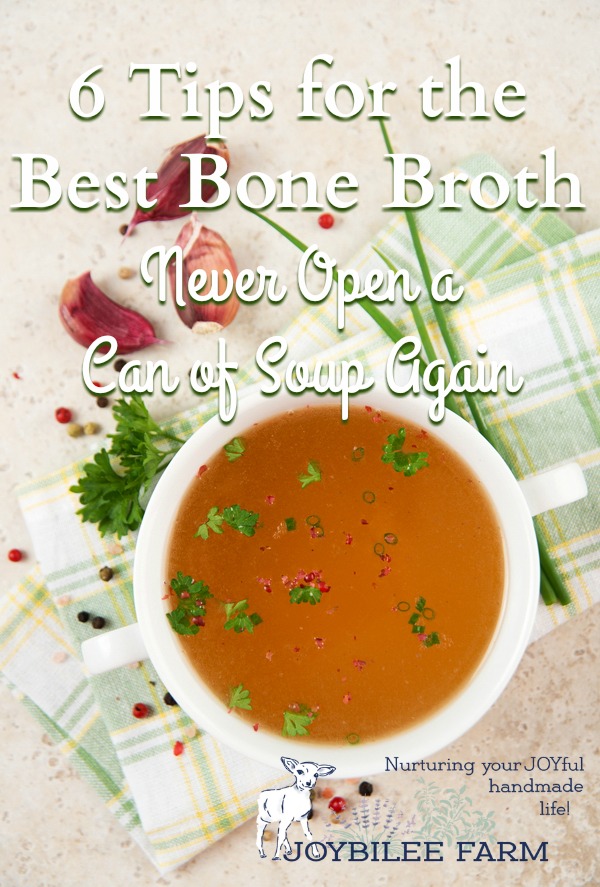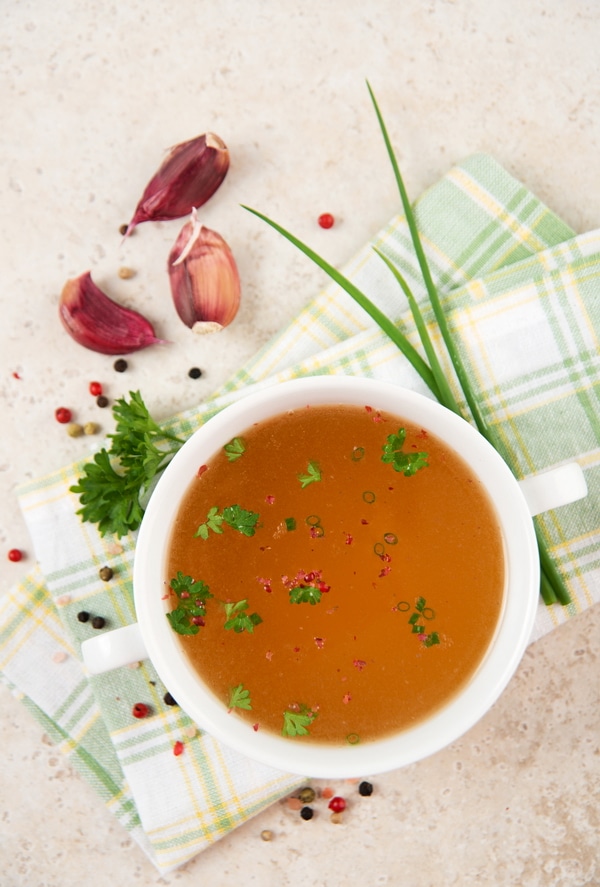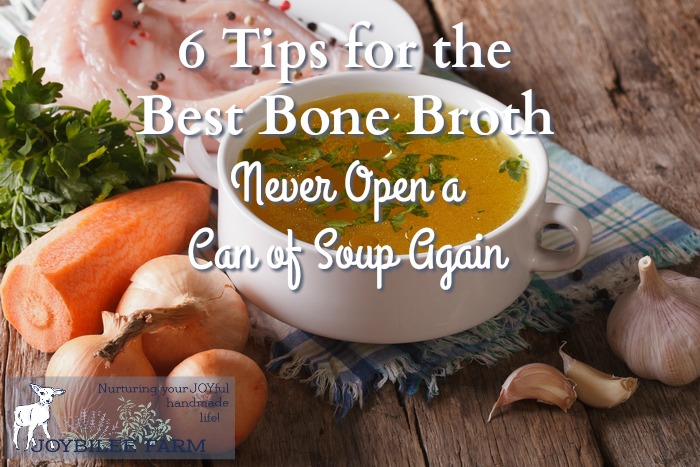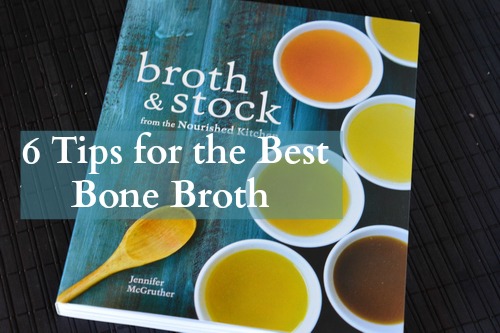Bone broth is built on a foundation of meat and bone; vegetable and herb, vinegar or wine, as Jennifer McGruther states in “Broth and Stock, from the Nourished Kitchen.” Clear broth provides the foundation for many savoury dishes from around the world, such as soups and stews, sauces and gravy, and braising liquids for vegetables and meat. Many cooks get their flavourful broth from a can of consommé, broth, or bullion. But you can easily make it at home with a slow cooker, InstantPot®, or anenamel-lined cast iron pot at the back of the woodstove, like grandma used to do.
Plus when you make your own bone broth at home, you capture the nutritious, gut-healing collagen that is inherent in the bones and connective tissue used to make clear broth and flavourful stock.

Making stock or bone broth begins with meat on the bone. It is simmered for 12 to 18 hours for beef, 8 to 12 hours for chicken, or under an hour for fish, with their delicate bones. For a quick vegetarian choice, mushrooms and vegetables need only 30 minutes to transform water into an umami broth.
The new book from Nourished Kitchen writer Jennifer McGrunther, offers basic recipes for successful stocks and broths made with beef, pork, chicken, fish, shell fish, and vegetables. Included in the book are such classics as Beef Tea, Beef Consommé, Clam Chowder, chicken soup, turkey soup, and dashi.
The book begins with Master Stocks that are then used for dishes that fill out the daily menu from morning broth, to lunch soup, and hearty main dish meals based on stock. Why would you want to eat broth three times a day? Broth offers several benefits. In fact, it’s become so popular that food trucks and restaurants devoted to serving daily broth are popping up in cities around North America.

Chicken broth and ingredients on the table close-up. horizontal, rustic style
Benefits of bone broth:
Easy to digest
Broth is the food of convalescence. It nourishes the immune system and fights inflammation.
Broth contains natural cartilage building collagen.
Collagen aids in building joint tissue and lubricating the joints for ease of movement. Broth is full of easily digested collagen.
Thrift
Making broth uses up otherwise discarded parts of butchered animals or vegetables. If you make bone broth instead of composting vegetables or throwing out the bones, it’s almost free.
Increase bioavailability of minerals
Slow cooking releases minerals and vitamins into the stock that are otherwise unavailable. These minerals are the building blocks of teeth and bone, joints and marrow. Bone broth is part of Dr. Price’s prescription for curing tooth decay.
Increases the flavour of other foods
The slow cooking of broth increases the naturally occurring glutamates which give the umami flavour to foods, satisfying our hunger. When used for braising vegetables or cooking rice or potatoes these flavours transform otherwise bland dishes into flavourful main courses.

6 Tips for More Nourishing and Flavourful Broths
As I was reading through Broth and Stock I found five nuggets of wisdom for the very best clear broth. If you apply these tips you’ll move your bone broth from ho-hum to gourmet.
Roast your Bones First
Beef bones become more flavourful when they are roasted in a slow oven before simmering in broth. Chicken and turkey bones, too, increase in flavour when they are slow roasted on a whole bird, before being stripped of meat and added to the soup pot.
Add the vegetable trimmings for flavour
Carrot peels, parsnip tops, parsley stems, onion skins, while not savoury alone, add immense flavour and extra vitamins and minerals to stock. You’ll strain them out before preserving the stock, so it doesn’t matter how ugly they are. Keep them clean.
Strain the broth to remove the solid parts
Broth should be clear and free of solids. Once the broth has simmered for the required amount of time, strain out the solid pieces and return the clear broth to the pot. This may seem wasteful, but there is no more flavour left in the meat. All the minerals have leached into the water. Strain judiciously.
Reduce
The broth can be further reduced till most of the water has evaporated. Concentrated broth can be dehydrated or frozen in small portions to save on storage space. It adds deep flavour to other dishes without the sugar and chemicals in commercial bouillon cubes.
Make your own bouillon cubes
Move over OXO. You can make your own bouillon cubes by simply dehydrating the stock further in an electric dehydrator until it is a crystalized sheet. Then grind it to a powder in a spice or coffee grinder. It dissolves instantly in hot water. It will keep at room temperature indefinitely in this form. Use it as you would commercial bullion.
Use wine or vinegar
The acid in wine or vinegar helps calcium rich bones release their minerals into the stock. Wine works the same way as vinegar. Red wine for beef, white wine for fish and chicken works for stocks, too. Add ¼ to 1 cup of dry white or dry red wine. McGruther advises that wine adds more flavour than vinegar.

About Broth and Stock
Broth and Stock is the second book by the Nourished Kitchen Blogger Jennifer McGrunther. You can see my review of her first book Nourished Kitchen here.

I like her casual and comfortable writing style. Her recipes are creative. The photography is inspiring. There are no canned or bottled ingredients. The book is about stocking your pantry with the basics so that you always have the makings of home cooked meals on hand, that are densely nourishing, and deeply satisfying. That’s how the book is, too: Deeply satisfying. Although I suggest you eat before you read it. Looking at the pictures made me hungry for chicken noodle soup.
Get Broth and Stock, from the Nourished Kitchen or pick up Jennifer McGrunther’s first book, Nourished Kitchen.
Disclaimer:
I received a review copy of Broth and Stock from Blogging for Books. This post contains affiliate links.



I am having trouble “canning” right now. Can I cook this for about 24 hours, put it in a mason jar and stick it in the refrigerator for how long? I put it in to get the fat off of it.
Thank you so much!!
Kathie
kpturpin@gmail.com
I like the idea of dehydrating the stock for homemade bullion. I recently read someone else describe that they did this by reducing the broth down till it was getting thick before spreading on the dehydration sheets.
I’ll have to try this soon.
I’ve been making my own stock for years, but it often has a bit of a sour aftertaste. I can’t figure out what’s causing this.